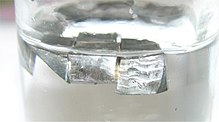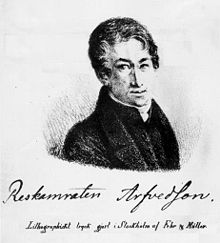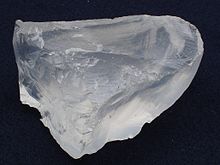Lithium
![]()
This article is about the chemical element lithium; for other meanings, see Lithium (disambiguation).
Lithium (derived from ancient Greek λίθος líthos, German 'stone'; pronunciation [ˈliːti̯ʊm] or also [ˈliːʦi̯ʊm]) is a chemical element with the symbol Li and atomic number 3. It is an element of the 1st IUPAC group, the group of alkali metals, and belongs to the second period of the periodic table of the elements. Lithium is a light metal and has the lowest density of the elements that are solid under standard conditions.
Lithium does not occur elementally in nature due to its high reactivity. At room temperature, it is only stable for a long time in completely dry air, but reacts slowly to form lithium nitride (Li3N). In humid air, a dull gray layer of lithium hydroxide quickly forms on the surface. Like all alkali metals, elemental lithium reacts on contact with skin moisture, causing severe burns and chemical burns. Many lithium compounds that form lithium ions in aqueous solution, unlike the corresponding sodium and potassium compounds, are labeled as harmful to health.
As a trace element, lithium in the form of its salts is a common component of mineral water. Small amounts of lithium are present in the human organism; however, the element is not essential and has no known biological function. However, some lithium salts have a medicinal effect and are used in lithium therapy for bipolar affective disorder, mania, depression and cluster headaches (see Medicine).
History
Lithium was discovered by the Swede Johan August Arfwedson, who in 1817 detected the presence of a foreign element in petalite (Li[4]Al[4][Si4O10]) and soon after in spodumene (LiAl[Si2O6]) and lepidolite (K(Li,Al)3[(Al,Si)4O10](F,OH)2) when he analyzed mineral finds from the island of Utö in Sweden. His academic teacher Jöns Jakob Berzelius suggested lithion, a derivative to Greek λίθος líthos 'stone', as the name, which, corresponding to the names of the other two alkali metals known at the time, sodium and potassium, refers to the material from which it was obtained. The Latinized form lithium has prevailed.
In 1818, the German chemist Christian Gottlob Gmelin noticed that lithium salts give a red flame coloration. Both scientists failed in the following years with attempts to isolate this element. In 1818, William Thomas Brande and Sir Humphry Davy succeeded for the first time by means of an electrolytic process from lithium oxide (Li2O). In 1855, Robert Bunsen and Augustus Matthiessen produced larger quantities of pure lithium by electrolysis of lithium chloride (LiCl). In 1917, Wilhelm Schlenk synthesized the first organolithium compounds from organic mercury compounds.
The first commercial production was started in 1923 by the German Metallgesellschaft at the Hans-Heinrich smelter in Langelsheim in the Harz mountains by electrolyzing a melt of lithium and potassium chloride (KCl).
Until shortly after the Second World War, there were hardly any applications for lithium except for its use as a lubricant (mineral oil thickened with lithium stearate) and in the glass industry (lithium carbonate or lithium oxide). This changed when tritium, which can be extracted from lithium, was needed in the United States for the construction of hydrogen bombs. Widespread mining began, especially at Kings Mountain (North Carolina). Due to the large quantities of lithium needed because of the short tritium half-life, a large stockpile of lithium was accumulated between 1953 and 1963, which was not put on the market until after the end of the Cold War, starting in 1993. In addition to mining, cheaper extraction from brines now became important. Larger quantities of lithium are now used for batteries, for the polymerisation of elastomers, in the construction industry and for the organic synthesis of pharmaceuticals and agrochemicals. Since 2007, primary batteries and accumulators (secondary batteries) have been the most important segment.

Lithium pieces, for protection against oxidation in paraffin oil

Johan August Arfwedson, discoverer of lithium
Occurrence and mining
Occurrence on earth
Lithium has a share of about 0.006 % in the earth's crust. It is thus somewhat less common than zinc and more common than cobalt, tin and lead in the earth's crust. Although lithium is more abundant than lead, for example, its greater distribution makes it difficult to extract. Lithium is present in drinking water and some foods such as meat, fish, eggs and dairy products. For example, 100 g of meat contains about 100 μg of lithium. Various plants, such as tobacco and buttercups, absorb and accumulate lithium compounds from the soil. The average content in the dry matter of plants is between 0.5 ppm and 3 ppm. Seawater contains an average of 180 µg/L and river water about 3 µg/L.
Reduction and reserves
In terms of volume, 35,000 tonnes of lithium were extracted outside the US in 2015 and traded predominantly as lithium carbonate (Li2CO3). In 2016, Chile was the largest producer. Australia tripled its production between 2016 and 2017 and increased it again by nearly 50% in 2018. Currently (2018), almost two-thirds of Australia's lithium supply is extracted from hard rock mining and only about one-third from brines. Reserves in existing mines are estimated at around 17 million tonnes (as of January 2020). The world supply from continental brines, geothermal brines, from the hectorite mineral, oilfield brines and from the magmatic rock pegmatite has been estimated at 80 million tonnes.
The largest resources are in Bolivia (21 million tonnes), Argentina (17 million tonnes), Chile (9 million tonnes), USA (6.8 million tonnes), Australia (6.3 million tonnes) and China (4.5 million tonnes). In Europe, Germany (2.5 million tonnes) and the Czech Republic (1.3 million tonnes) have the largest reserves.
| Worldwide production [tons] | 2014 | 2015 | 2016 | 2017 | 2018 | 2019 (estimated) | Mining Reserves | World Resources |
| Bolivia | n.v. | n.v. | n.v. | n.v. | n.v. | n.v. | 9.000.000 | 21.000.000 |
| Chile | 11.500 | 10.500 | 14.300 | 14.200 | 17.000 | 18.000 | 8.600.000 | 9.000.000 |
| China People's Republic of | 2.300 | 2.000 | 2.300 | 6.800 | 7.100 | 7.500 | 1.000.000 | 4.500.000 |
| Australia | 13.300 | 14.100 | 14.000 | 40.000 | 58.800 | 42.000 | 2.800.000 | 6.300.000 |
| Argentina | 3.200 | 3.600 | 5.800 | 5.700 | 6.400 | 6.400 | 1.700.000 | 17.000.000 |
| Portugal | 300 | 200 | 400 | 800 | 800 | 1.200 | 60.000 | 250.000 |
| Brazil | 160 | 200 | 200 | 200 | 300 | 300 | 95.000 | 400.000 |
| United States | n.v. | n.v. | n.v. | n.v. | n.v. | n.v. | 630.000 | 6.800.000 |
| Zimbabwe | 900 | 900 | 1.000 | 800 | 1.600 | 1.600 | 230.000 | 540.000 |
| Canada | n.v. | n.v. | n.v. | n.v. | 2.400 | 200 | 370.000 | 1.700.000 |
| Congo Democratic Republic | n.v. | n.v. | n.v. | n.v. | n.v. | n.v. | n.v. | 3.000.000 |
| Russia | n.v. | n.v. | n.v. | n.v. | n.v. | n.v. | n.v. | 1.000.000 |
| Serbia | n.v. | n.v. | n.v. | n.v. | n.v. | n.v. | n.v. | 1.000.000 |
| Mexico | n.v. | n.v. | n.v. | n.v. | n.v. | n.v. | n.v. | 1.700.000 |
| Austria | n.v. | n.v. | n.v. | n.v. | n.v. | n.v. | n.v. | 50.000 |
| World | 31.700 | 31.500 | 38.000 | 69.000 | 95.000 | 77.000 | 17.000.000 | 80.000.000 |
Primary deposits
Lithium occurs in some minerals in lithium pegmatites. The most important minerals are amblygonite (LiAl[PO4]F), lepidolite (K(Li,Al)3[(Al,Si)4O10](F,OH)2), petalite (Kastor; LiAl[Si4O10]) and spodumene (Triphan; LiAl[Si2O6]). These minerals have a lithium content of up to 9% (for amblygonite). Other, rarer lithium ores include cryolithionite (Li3Na3[AlF6]2), which has the highest lithium content of any mineral, triphyline (Li(FeII,MnII)[PO4]), and zinnwaldite (K(Li,Fe,Al)3[(Al,Si)4O10](F,OH)2). Lithium minerals occur in many silicate rocks, but usually only in low concentrations. There are no large deposits. As the extraction of lithium from these minerals requires a lot of effort, they play a minor role in the extraction of lithium or lithium compounds today, but this could change due to the expected high demand. Mining sites are mainly the Greenbushes and Mt. Cattlin mines in Western Australia, where pegmatite rocks have high lithium concentrations and where lithium is a by-product of tantalum mining. Spodumene is also mined for lithium in some other countries such as Canada and Russia, and until 1998 also in Bassemer City, North Carolina.
Europe has Li-rich pegmatite fields on the Carinthian wine plain in the district of Wolfsberg, in the Finnish region of Österbotten, in the Ore Mountains and between Spain (Almendra) and Portugal (Guarda district, Boticas).
While the first commercial production of lithium compounds per se began in 1923 in the Harz Mountains, production in the now newly developed significant deposits in Austria and Finland could begin from 2021. They are operated by Global Strategic Metals and Keliber, respectively. In Austria at the Koralpe in the Lavant Valley, test tunnels have revealed a much larger deposit of lithium-bearing bedrock, estimated at 22 million tonnes. This makes it one of the first large-scale lithium mining projects in Europe and could be operated for 20 years. The deposit near Zinnwald in the Ore Mountains is being explored by Deutsche Lithium.
Secondary deposits
Lithium salts, especially lithium chloride, are also commonly found in brines, mostly salt lakes. The concentration can be up to one percent. In addition to the concentration of lithium, the quantity ratio of magnesium to lithium is important for the quality of the brine. Currently, lithium is mainly extracted in Chile (Salar de Atacama, which has one of the highest known lithium concentrations at 0.16 %), Argentina (Salar de Hombre Muerto), the United States of America (Silver Peak, Nevada) and the People's Republic of China (Chabyêr Caka, Tibet; Taijinaier Lake, Qinghai). Bolivia's Salar de Uyuni salt lake, with an estimated 5.4 million tonnes of lithium, may hold the largest resources. The state-owned company Yacimientos de Litio Bolivianos has been investing more in its industrialization since 2018 with German and Chinese partners, including the neighboring Salar de Coipasa and Laguna Pastos Grandes. There are other lithium-bearing salt lakes that (as of April 2019) have not yet been exploited for industrial mining, for example in China, Argentina and Afghanistan. In 2016, it became known that in the Paradox Basin in the US state of Utah, high-saline deep groundwater (brine) was encountered during oil exploration drilling as early as the 1960s, from which, according to analyses at the time, up to 1700 mg/L of pure lithium could be extracted.
Potassium carbonate (potash), borax, cesium and rubidium are often obtained as co-products in lithium extraction.
Due to the expected strong demand for lithium for electric vehicle batteries, in 2010 a number of companies examined the mining of lithium-bearing minerals and brines in various regions of the world, including Europe. Research is also being conducted into lithium extraction from seawater. There are about 230 billion tons of lithium dissolved in the world's oceans. In 2018, researchers presented an extraction method in which lithium can be extracted from seawater via solar-powered electrolysis. As an advantage over conventional extraction, they cited the fact that the process directly produces metallic lithium and therefore eliminates the need for the (complex and energy-intensive) further processing required in traditional lithium extraction from ores.
At the Leibniz Institute for New Materials, the two-year MERLIN (mining water lithium extraction) research project was launched in November 2020 to test the extraction of lithium from mine water.
Occurrence outside the earth
After the Big Bang, in addition to hydrogen and helium isotopes, a considerable amount of the isotope 7Li was also created. For the most part, however, this is no longer present today, as lithium has been fused with hydrogen in stars in the process of the proton-proton reaction II and thus consumed. In brown dwarfs, however, the mass and temperature are not high enough for hydrogen fusion; their mass does not reach the necessary size of about 75 Jupiter masses. The lithium formed in the Big Bang thus remained in larger quantities only in brown dwarfs. For this reason, lithium is also a relatively rare element extraterrestrially, but it can be used to detect brown dwarfs.
The distribution of lithium in different stars varies greatly, even if the age, mass and metallicity are similar. Planets are thought to have an influence on the lithium content of a star. If a star has no planets, the lithium content is high, while stars like the Sun that are surrounded by planets have low lithium content, also known as a lithium dip. The cause is thought to be that the tidal forces of planets contribute to more mixing of outer and inner layers in stars, allowing more lithium to reach an area hot enough to fuse it.

Petalit
Questions and Answers
Q: What is the symbol for lithium?
A: The symbol for lithium is Li.
Q: What is the atomic number of lithium?
A: The atomic number of lithium is 3.
Q: How many protons are in the nucleus of a lithium atom?
A: There are 3 protons in the nucleus of a lithium atom.
Q: What are the two common isotopes of lithium?
A: The two common isotopes of lithium are 6Li and 7Li.
Q: Which isotope is more common?
A: 7Li is more common, making up 92.5% of all naturally-occurring lithium atoms.
Q: What properties does lithum have?
A: Lithium has a soft, silver-white color and it is very reactive.
Search within the encyclopedia